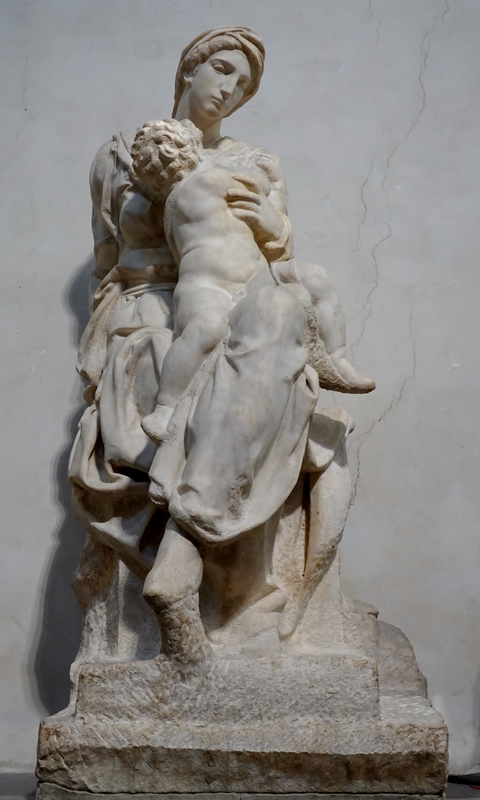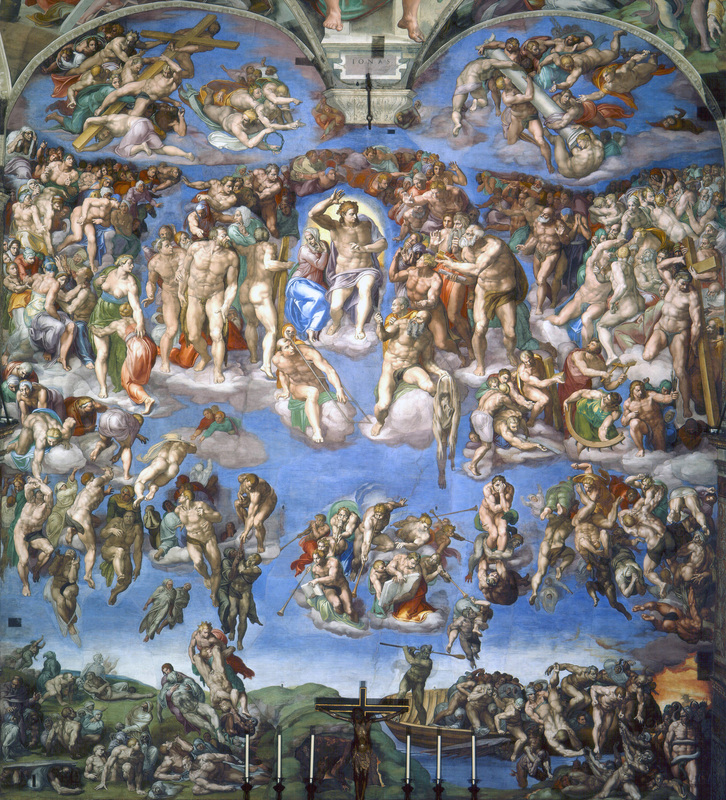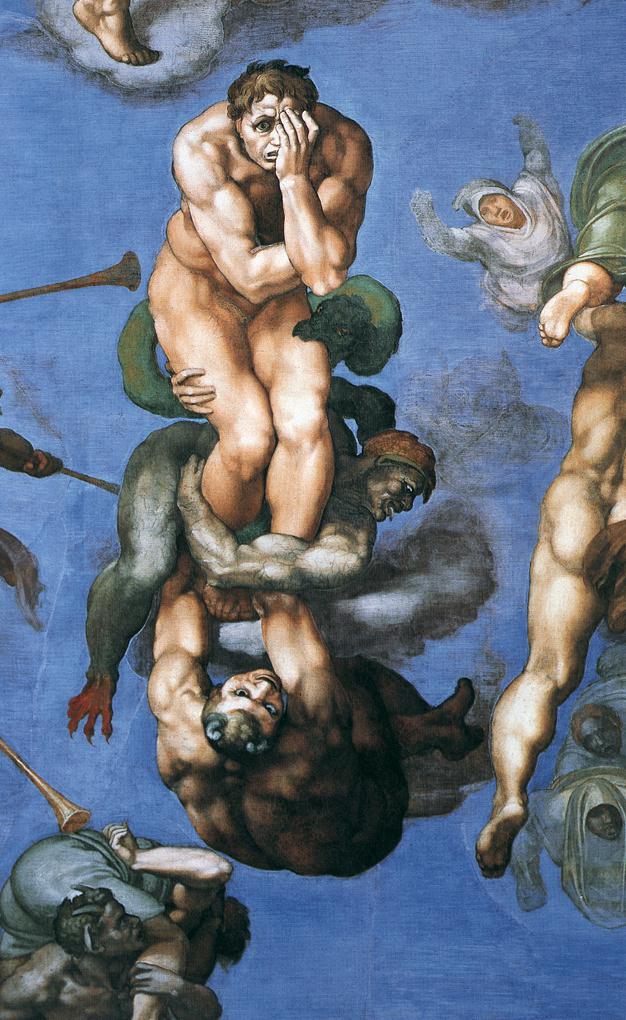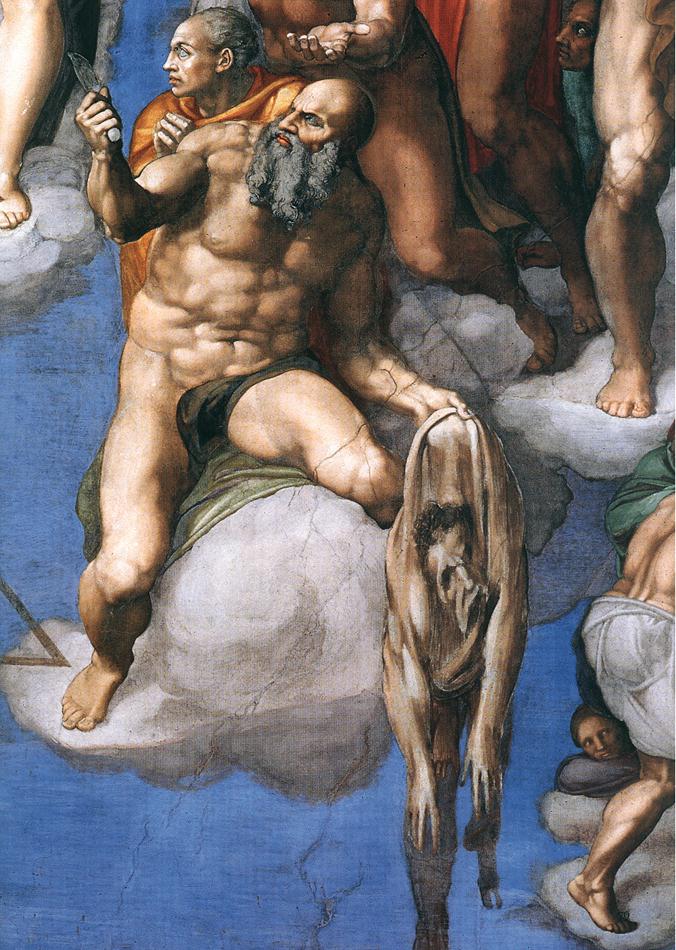Michelangelo moved back to his hometown of Florence in 1513, shortly after the death of his patron and frenemy Pope Julius II. He created much beauty there and occasionally elsewhere during the two decades that followed, but if you had asked the lugubrious artist about his recent life in 1534, the year that he decided to shift his base of operations away from Florence and back to Rome permanently, he would likely have spoken of it as little more than a series of frustrating setbacks. For over that twenty years he finished relatively little of the art that he started to the standards he had first imagined for it. Blown about by the winds of Church and secular politics, stymied repeatedly by his own habit of planning grandiose projects and then refusing to delegate even trivial aspects of the labor to others, he left in his wake a long string of incomplete or abbreviated masterpieces. These orphans had to find homes where they could when the larger installations for which they had been earmarked, from the perpetually in-the-offing tomb for Julius in Rome to a new interior for the Basilica of San Lorenzo in Florence, failed to come together, the victims of shifting fashions and unstable finances.
And yet what orphans these pieces were! One view of the role of the artist is to be a sort of distillation of his times, converting the most essential elements of the zeitgeist into pigment or stone or letters. However else he can be read, Michelangelo can be appreciated very satisfactorily indeed in this way. After the naked triumphalism of the Sistine Chapel ceiling, his later art reflected the sense of displacement and insecurity that followed Julius’s death, when the warrior pope’s all-powerful, all-dominant Catholic Church was suddenly being questioned as never before, and seemed constitutionally incapable of devising a coherent response.
Michelangelo’s greatest works of the period between 1513 and 1534 were arguably the statues he sculpted for a Medici chapel and tomb inside the Basilica of San Lorenzo. The project went half-finished like so much else, but what can be seen there today displays a whole new aesthetic in tune with the changing times. Miles J. Unger:
The Medici Chapel chronicles the passing of one age and the emergence of another. Beneath its graceful cupola the optimistic spirit that characterized the Renaissance congeals, replaced by a mood of anxiety; faith in reason is replaced by expressions of doubt; civic values decay into morbid introspection. In the eccentricity of his architecture and in the odd distortions Michelangelo imposed on his figures, one can detect the emergence of a new expressive language, one that usually goes under the rather elastic term of “Mannerism.” The motifs of classicism are shuffled, yielding quirky new combinations, while the human form, home to a restless spirit yearning for something that mere flesh cannot encompass, is stretched Gumby-like past all plausibility. The search for balance, the supreme confidence in Man’s ability to master his environment, is rejected in favor of forms that exhibit insufficiency; the heroism of a doomed struggle against fate is preferred to the harmonious resolution of conflict.

The unmoored quality of the new age was even more palpable in Florence than elsewhere in Italy. The venerable city-state had never entirely recovered from the damage Girolamo Savonarola had done to its once-matchless self-confidence, and it was now in the midst of an undeniable political, economic, and artistic decline. Thus the 59-year-old Michelangelo’s reluctant decision to leave the city of his birth and return to Rome in search of richer patrons and better commissions. Most of all, he still dreamed of completing the crazily elaborate tomb for Pope Julius which he had begun to plan more than a quarter of a century before. He wanted to see the project through not so much out of any enduring love for Julius himself as for the love of his own aesthetic vision for it — or perhaps, the less charitable might be tempted to say, to validate his own ego that had conceived it.
He arrived in Rome just two days before the death of Pope Clement VII. As usual, he proceeded to absorb the atmosphere of his surroundings, preparatory to radiating it in his art. He was dismayed by what he observed; the days of the warrior pope seemed almost as distant to the Romans of 1534 as did those of said pope’s idol Julius Caesar. Rome was still profoundly traumatized by its sacking of seven years earlier. The programs of civic improvement initiated by Julius in the hope of making the city an imperial capital worthy of the name once again had long since stalled out in lethargy and distraction. The new Saint Peter’s Basilica was still a cathedral without a dome — a painfully apt metaphor, many commentators said, for the current state of both the city and the Church.
Yet the pope who came after Clement seemed happy to live in denial of recent events, happy to be a throwback to bygone days of glory; Paul III was, as Richard P. McBrien writes, “a Renaissance pope in the fullest sense of the word.” An energetic 67 years old at the time of his crowning, he was a Roman born and bred, the first native son of the city to become pope in 103 years. He had at least four illegitimate children whom he took no pains to conceal, and enjoyed the finer things of this life unabashedly, hosting weekly masked balls and banquets, even an annual carnival. He really did seem to be trying to turn back the clock, to pretend that Martin Luther had never nailed his 95 Theses to that door in Wittenberg, that the Reformation had never happened, and that the Holy Mother Church he headed still reigned supreme and inviolate throughout Europe. Inside his palace, where the food and fabrics were as rich as ever, it was almost possible to believe all of these things. It was only when one walked out onto the melancholy, still partially burnt-out streets surrounding it that the doubts set in.

If he was to be a proper Renaissance pope, Paul needed to have the greatest artist of the age at his beck and call. By virtue of attrition if nothing else, that title now belonged to Michelangelo alone; Leonardo da Vinci had died a fairly old man by the standards of his time in 1519, Raphael a young one in 1520. (Needless to say, the ever-vindictive Michelangelo relished having outlasted both of his enemies.) Paul put Michelangelo on his permanent payroll, as it were, naming him his “supreme architect, sculptor, and painter, and a member of our household with all favors, prerogatives, honors, duties, and preferences that are enjoyed or can be enjoyed by all our familiars.” Desperate though he had been in his younger years to avoid any such kept status, Michelangelo accepted it now with relief, thanks to the modicum of stability it offered in this new chaotic age. If the artist is to be believed, he and Paul grew downright chummy. “My important duties have given me so much license,” he wrote in a letter to a friend, “that when I am talking to the pope I put this old felt hat nonchalantly on my head, and talk to him very frankly.”
Paul soon proposed to send his private artist back into his private chapel — the Sistine Chapel, that is — to paint the wall behind the altar. In fact, Michelangelo had already corresponded with Pope Clement about the same project before the latter’s death. Conventional thinker that he was, Clement had suggested a rather conventional image here, of the resurrection of Jesus Christ. But Michelangelo had his heart set on a far more ominous tableau, nothing less than an enormous panorama of the Last Judgment. The symmetry of going from the creation of the world up there on the ceiling to the end of the world on the altar wall made it a hard argument to resist. Accordingly, Paul gave Michelangelo free rein to offer up his vision of the ultimate resolution of the Christian saga.
So, in April of 1535, Michelangelo returned to the Sistine Chapel in his rough-hewn working clothes. The scaffolding went up behind a curtain that would hide the wall from public view until it was finished, the air was filled with the acrid smell of plaster and quicklime, and all there felt much as it had in an earlier time of artistic creation. The altar wall already sported a set of frescoes by Pietro Perugino, a deceased old master whom Raphael had once served as an apprentice; they showed the baby Moses and the baby Jesus flanking the Virgin Mary as she was taken up to Heaven. Michelangelo destroyed them without a second thought, as he did his own depictions above them of the first seven ancestors of Jesus, as listed in the genealogy which opens the New Testament. In doing so, he spoiled one of the principal motifs of his chapel ceiling, but he obviously had other priorities now. He ordered masons to re-brick the entire altar wall in an unusual way, such that it sloped inward as it rose. Sculptor rather than painter that he considered himself to be in his heart of hearts, he always thought in three dimensions, and knew that the looming, vertiginous quality of the sloping wall would heighten the impact of the intentionally oppressive artwork he intended to create.
He began the actual painting in the spring of 1536, and continued for the next five years. Unlike with the chapel ceiling, where he had grudgingly agreed to employ assistants in order to complete the project more quickly, here Michelangelo insisted on making virtually every stroke of the brush himself. In terms of sheer sustained personal effort, The Last Judgment was the most taxing of all Michelangelo’s creations, even more so than the chapel ceiling; work records reveal that he spent 450 days in all over those five years perched precariously up there on the scaffold, painting away. (He would undoubtedly have preferred to keep an even more intense schedule, but the vagaries of fresco painting meant that only a subset of days and seasons were suitable. He employed much of his “downtime” planning and drawing cartoons of the sections of wall to come.) By all indications, the project was among his most personally satisfying as well as taxing; shielded from the demands of the outside world by his position in the papal court, he was left alone to simply paint, free of the scramble to satisfy patrons and contracts that fills so much of most artists’ time, both then and now.
That said, the physical strain of the task must have been daunting for a man in his sixties. Yet he persevered, single-handedly covering his vast canvas of more than 2000 square feet (185 square meters) with more than 400 individual figures. In the last days of the work, when he had only a small portion of the lower left corner still to go, he fell off his scaffold and broke his leg. He was fortunate to have done so at this juncture; if he had been painting elsewhere, higher up on the wall, he might very well have been killed. As it was, he had to allow his enthusiastic but less gifted apprentice to complete the last part of the work. The difference in skill is plainly evident on the wall today.

The Last Judgment was certainly a labor of love for Michelangelo, perhaps even more so than than the chapel ceiling, a commission he had accepted with far more reluctance. And yet it contains no images that are as universally recognized and even beloved today as that of God giving the spark of life to Adam. In fact, it is in many ways the most controversial artwork Michelangelo ever produced, being a difficult piece to warm to even as one can’t help but admire the immensity of its ambition and its visceral impact on the viewer. It is a nightmare rather than another of the orderly dreams we normally associate with Renaissance art, horrifying in its stark, primordial intensity. Having outlived the Renaissance that had given birth to him, Michelangelo left its values behind in his art as well, not least among them the humanist ideal of man as captain of his own destiny. Here all of humanity is a plaything in the hands of an angry God, with no sign of a Noah to provide a second chance. Like the Book of Revelation that served as its inspiration, The Last Judgment takes place in the timeline of the New Testament, but its God is the vengeful, unforgiving figure of the Old.
If asked to describe The Last Judgment in one word, I would have to choose the word “savage.” There is plenty of violence on the chapel ceiling as well, of course, but there it is the product of a righteous, almost stately divine anger. The Last Judgment, on the other hand, revels in its cruelty. Its most obvious analogue in earlier art is not anything by the younger Michelangelo but rather the Hieroynmous Bosch painting with which it shares a name. Here as there, Jesus Christ sits serenely looking on while the many damned suffer for their sins and the few saved fly up to Heaven. Like Bosch’s, Michelangelo’s Last Judgment is fundamentally Medieval in outlook — and yet it is realized with all the fine technique of the late Renaissance, making for an incongruous combination in the eyes of some. Will Durant:
The sculptor in [Michelangelo] ruined the painting. This stern puritan, who day by day became more religious, insisted on carving in color massive and muscular bodies, until the angels that art and poetry had conceived as happy children, gracious youths, or lithesome girls, became in his hands athletes racing through the skies. Even Christ Himself, in His majestic anger, became an incarnation of the Adam of the Sistine ceiling, a god made in the image and likeness of man. There is too much flesh here, there are too many arms and legs, biceps and swelling calves, to lift the soul to contemplate the wages of sin.
Many another critic has echoed Durant’s complaint that the sheer physicality — even carnality — of the fresco undermines the warning it purports to present about the temptations of the flesh. There is just something off about, as Michelangelo’s Modern biographer Martin Gayford puts it, “a large number of groins, penises, breasts, testicles, and buttocks [that] appear to float above the altar of the pope’s chapel.” In places, the effect is almost comic. One poor damned soul looks like he’s squatting over a toilet with a bad case of constipation, whilst trying to protect his penis from a demon who seems determined to nip it off.

But any irony we may detect is surely unintentional; there is no question that Michelangelo was absolutely sincere in his religious convictions, absolutely certain of the fates that awaited both sinners and the righteous. He didn’t spare himself from personal inquisition; by now, he was writing tortured sonnets almost weekly, lambasting himself for unspecified lusts and weaknesses. (Perhaps tellingly, the other principal subject of his poetry during this period was a handsome Roman nobleman of less than half his age with whom he had become wildly infatuated: “No better guide the ardent heart that loves and longs, than a comely face in whose eyes we see reflected Heaven’s grace.”) One of the most striking figures on The Last Judgment is that of Saint Bartholomew, one of Jesus’s original twelve apostles, who was according to legend skinned alive by pagans to whom he was attempting to proselytize. We see him on the altar wall holding up his own flayed skin — but the face on the slack garment is Michelangelo’s wrinkled, aging visage.

Although his life, career, and artistry were far too embedded in the Catholic establishment for him to flirt with Protestantism, Michelangelo was always bothered by the chummy hypocrisy he saw all around him in Rome, by the supposed men of God, from the pope on down, who sinned so brazenly and thoughtlessly. He grew only more troubled as he aged and his religiosity increased. In light of this, it is hard not to read an implicit message — even an implicit rebuke — into The Last Judgment as the backdrop to services conducted by Pope Paul III, who was like most of his Renaissance predecessors such a far cry from any paragon of ecclesiastical virtue. At the same time, though, Michelangelo was never above using his art to settle worldly scores: a number of the damned souls whom he painted on the altar wall sported faces selected from his consistently lengthy, painstakingly curated list of enemies. His was a soul expansive enough to contain multitudes, one in which the sublime and the petty could thrive side by side.
The Last Judgment was unveiled to the world on All Hallows Eve, 1541, exactly 29 years after the official unveiling of the complete Sistine Chapel ceiling. It was the biggest day in Michelangelo’s life since that one, with artists and dignitaries coming from far and wide to see the work. Yet the altar wall wasn’t greeted with the same unadulterated praise as the chapel ceiling had been. Martin Gayford compares the scene in and around the chapel to the opening of an exhibition by a controversy-courting artist of our own day, while R.A. Scotti notes simply that “few works of art have provoked greater outrage or greater awe than The Last Judgment.” The Theatines, a group within the Church dedicated to guiding the clergy back to lives of chastity and asceticism, proclaimed stridently that “nudes displaying their goods in such a place is not right.” Another commentator wrote in an open letter to the artist that “a brothel would avert its eyes in order not to see such things. What you have done would better suit a voluptuous bathhouse than the supreme chapel!” Indeed, the presence of so much naked flesh here at the very nerve center of the papacy stuck even many of the less zealous and more practical-minded as politically ill-advised, a flagrant confirmation of the accusations Martin Luther had spent the last 25 years hurling at the Catholic Church. The work has continued to divide the waters within and without the Church right down to the present day.

Seen from a historical perspective, The Last Judgment speaks volumes. The swirling maelstrom on the altar wall, so different from the sumptuous orderliness of the ceiling, reflects the contemporary feeling in Europe that the old center no longer held. Many devout Catholics, among them Michelangelo himself, believed that the end times must be nigh at long last, that the Book of Revelation’s predictions of a breakdown of the social order that would lead to the apocalypse were finally coming to pass after countless false alarms.
But one doesn’t have to believe in the literal subject matter of the painting to pick up on the sense of chaos and dislocation that produced it. Once the rock upon which European society was planted, the very justification for the continent’s many kingdoms’ existence, Christianity was being inexorably sidelined, becoming a tool of the state rather than vice versa. The Age of Faith was over; the magnificent tableau of the Sistine Chapel ceiling showed that which had been, not that which currently was or was still to be. For Michelangelo and his peers, the shape of the new age to come was as hazy as the question of what would transpire the day after the violence depicted in The Last Judgment, or for that matter what had existed before the moments of creation depicted so vividly up there on the chapel’s ceiling. A darkness lay upon the face of the deep once again. The next enlightenment, when it came, would look very different from that of the age before.
Did you enjoy this chapter? If so, please think about pitching in to help me make many more like it. You can pledge any amount you like.
(A full listing of print and online sources used will follow the final article in this series.)


Leo Vellés
Superb chapter as always. One typo here: “…the air filled was filled with the acrid smell of plaster”
Jimmy Maher
Thanks!
Fredrik Arnerup
It is a startlingly ugly painting, isn’t it? It reads like somebody pasted random cut-outs on their blue wallpaper. The composition looks like it was made by a non-artist and the colours are not attractive, using lots of blue just to show that you can affort bucketloads of expensive pigment.
Martin
That brings up a good point, I don’t know enough of his works to answer but is there any evidence that he did know how to compose complete scenes. The stuff on the ceiling is good but they are small scenes that don’t need much composition. The scene on the end again shows character skill but minimal composition. Are there any other examples that show he knew how to compose a pleasing scene? OK, the subject matter he took on may not be pleasing event but it could still be composed in a pleasing way.
Jimmy Maher
If it was left up to him, Michelangelo would always prefer to sculpt rather than paint. The two stages of his work in the Sistine Chapel are by far his most ambitious paintings. There aren’t a large number of other examples of finished, painted pieces, although we have a lot of sketches.
That said, I think it’s a stretch to imagine that Michelangelo didn’t understand composition. That would have been a basic part of a Florentine art education. I think he was deliberately trying something new on the altar wall, to consciously or unconsciously reflect the state of the times. I do agree with you both, however, that the final effect is a bit off. Too much blue; color was definitely not Michelangelo’s strongest suit. And all those muscular male nudes — the subject Michelangelo loved above all others — are incongruous, betraying an artist too interested in pleasing himself at the expense of the artwork. As my first creative writing teacher told me, you have to be able to kill your darlings.
Fredrik Arnerup
It must be really hard though, keeping the colours consistent when you can only see a small portion of the picture at a time. How can you be sure that the blue of the sky is the same blue as on the other side of the room? I can only imagine Michelangelo carried around pieces of plaster with colour samples, for reference.
I wonder if the colours change when the plaster dries?